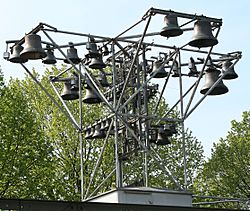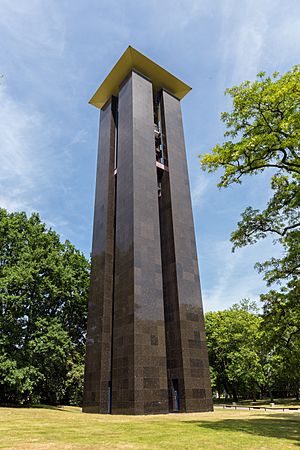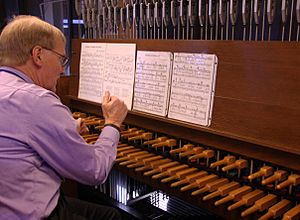Carillon facts for kids
 |
|
| Percussion instrument | |
|---|---|
| Classification | Percussion |
| Hornbostel–Sachs classification | 111.242.2 (Sets of bells or chimes) |
A carillon is a huge musical instrument made of many bells. You usually find carillons in tall bell towers. To be called a carillon, an instrument must have at least 23 bells. If it has fewer than 23 bells, it's called a chime.
The bells in a carillon are played using a special keyboard. It looks a bit like a piano or organ keyboard. But instead of pressing keys with your fingers, you hit large wooden "batons" with your closed fists. Each baton is connected to a bell. When you hit a baton, it makes its bell ring with a specific sound. The biggest bell, which makes the lowest sound, is called the "bourdon." Many carillons also have pedal keyboards for playing the largest bells with your feet.
Carillons are very heavy instruments. The heaviest one in the world is in a New York City church and weighs 91 tonnes! Some carillons, like the one in the Peace Tower in Ottawa, Canada, are played by a person called a carillonneur. Others are automated, meaning they play music by themselves.
Some carillons are controlled by a clockwork system, like the famous Big Ben clock. This allows them to play music at certain times each day. Examples include the Spasskaya Tower in the Moscow Kremlin and the Munntoren in Amsterdam. Newer carillons can even be controlled by a computer.
Contents
Learning to Play the Carillon
It's possible to learn how to play the carillon at several schools around the world. The Royal Carillon School "Jef Denyn" in Belgium is very well-known. Other places, like the LUCA School of Arts in Belgium and the Utrecht School of the Arts in the Netherlands, offer special programs. There are also carillon schools in Denmark, the United Kingdom, and France.
In North America, the Guild of Carillonneurs holds exams for players. If you pass, you become a certified carillonneur. Many universities in the United States, like the University of California, Berkeley and the University of Florida, offer courses where you can study the carillon. Sometimes, carillonneurs who work at these places also give private lessons. Some universities, like Yale, have student groups that manage performances on their carillons.
There are also music competitions for carillon players. The international Queen Fabiola Competition is one of the most important ones.
Where Are Carillons Found?
Organizations like the World Carillon Federation and TowerBells keep track of carillons worldwide. They count "traditional carillons" as those played with a baton keyboard, and "non-traditional carillons" as those that are computerized or electronic.
There are about 700 traditional carillons in the world. You can find at least three on every continent except Antarctica. However, most of them are in just a few countries. The Netherlands, Belgium, and the United States have about two-thirds of all traditional carillons. Over 90 percent are located in Western Europe (especially the Netherlands and Belgium) or North America.
In North America, most carillons are owned by churches or schools. In Europe, however, most are owned by cities or towns. Almost all traditional carillons were built in the last 100 years. Only about 50 very old carillons from the 1700s or earlier still exist. There are also about 483 non-traditional carillons, mostly in the United States and Western Europe.

Traveling Carillons
Some carillons are not kept in towers. These are called traveling or mobile carillons. Their bells and keyboard are set up on a special frame that can be moved around. These carillons have to be much lighter than the ones in towers.
The idea for a traveling carillon came from Nora Johnston between 1933 and 1938. She created a portable system using a traditional keyboard connected to chime bars. She even traveled to the United States to perform on radio shows and in concerts. Later, others built traveling carillons using real bells.
Today, there are about 20 traveling carillons. Most are in Western Europe and the United States. Bell-making companies often own them to show off their work. In the United States, two traveling carillons are part of a music group called Cast in Bronze. This group plays the carillon with other instruments to introduce the public to this unique instrument.
Images for kids
-
A carillonneur plays the 56-bell carillon of the Plummer Building, Rochester, Minnesota, US
-
The 56-bell carillon of Saint Joseph's Oratory, Montreal, Canada
-
Console of the carillon at the Church of the Sacred Heart in Maine-et-Loire, France
-
View of the bells and transmission system of the 49-bell Peace Carillon, Aarschot, Belgium
-
Front of the 16th-century clockwork and playing drum in the Sint-Catharijnetoren in Brielle, Netherlands
-
The tower of St. Rumbold's Cathedral in Mechelen, Belgium, where Jef Denyn generated worldwide interest in the carillon
-
Broken bells in a "bell cemetery" in Hamburg, Germany, 1947
-
Carillon music is written on a grand staff. The treble clef signifies playing with hands and the bass clef playing with feet.
See also
 In Spanish: Carillón para niños
In Spanish: Carillón para niños


















